Yorkshire Museum
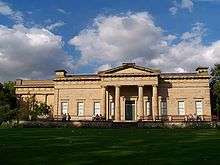 | |
| Established | 1830 |
|---|---|
| Location | York, England |
| Coordinates | 53°57′42″N 1°05′15″W / 53.96180°N 1.08744°W |
| Director | Reyahn King, York Museums Trust |
| Website |
www |
The Yorkshire Museum is a museum in York, England. It is the home of the Cawood sword, and has four permanent collections, covering biology, geology, archaeology and astronomy.
History
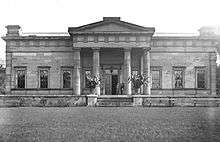
The Museum was founded by the Yorkshire Philosophical Society to accommodate their geological and archaeological collections, and was originally housed in Ousegate, York, until the site became too small. In 1828 the society received by royal grant, ten acres (0.040 km²) of land formerly belonging to St Mary’s Abbey for the purposes of building a new museum. The main building of the museum is called the Yorkshire Museum; it was designed by William Wilkins in a Greek Revival style and is a Grade I listed building. It was officially opened in February 1830, which makes it one of the longest established museums in England. A condition of the royal grant was that the land surrounding the museum building should be a botanic gardens and one was created in the 1830s. The botanic gardens are now known as the Museum Gardens. On 26 September 1831 the inaugural meeting of the British Association for the Advancement of Science was held at the Yorkshire Museum.[1]
The Tempest Anderson Hall was built in 1912 as an annex to the museum, and is an early example of a reinforced concrete building. It is used as a conference venue and lecture theatre.
In 1960, the Museum and Museum Gardens were given in trust to York City Council, the successor of which, the City of York Council, set up the York Museums Trust in 2002 to manage the York Castle Museum, York Art Gallery, the Yorkshire Museum and the Museum Gardens.[2][3]
The museum closed in November 2009 for a major refurbishment and reopened on Yorkshire Day on 1 August 2010. The £2 million scheme was largely carried out by the museum's own staff, who restructured and redecorated the interior of the building. As of January 2016 the museum has the following permanent exhibits: "Roman York – Meet the People of the Empire", "Capital of the North" (Anglian, Viking and Medieval York), and "Extinct: A way of life" a "fun, family-oriented gallery" featuring fossils, skeletons and animal specimens. There are also temporary exhibitions and a historic library and learning space. [4]
Collections
The four permanent collections at the museum all have English designated collection status, which means they are "pre-eminent collections of national and international importance".[5] The collection began in the 1820s with the collection of animal bones and fossils from Kirkdale Cave.[6]
Biology
The biology collection contains 200,000 specimens, including both fauna and flora, with the majority of the collection made up of insects. There are two stuffed specimens of the extinct great auk, an almost complete skeleton of an extinct moa, and a large collection of specimens from the Yorkshire region including the remains of elephants, cave bears and hyena from Kirkdale Cave dated to the Quaternary period, around 125,000 years.
Geology
The geology collection contains over 112,500 specimens of rocks, minerals and fossils. Fossils make up the majority of the collection numbering over 100,000 samples, and include important specimens from the Carboniferous, Mesozoic and Tertiary periods.
Astronomy
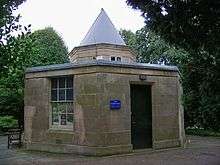
The astronomy collection is mainly kept in the observatory in the museum gardens with some telescopes kept at the Castle Museum in York.[7]
The observatory is staffed by volunteers.[8]
Archaeology
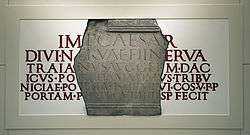
The archaeology collection has close to a million objects that date from around 500,000 BC to the 20th century.
Most of the objects from the Roman, Anglo Scandinavian and Medieval periods are from the York and Yorkshire area. Following the 2010 refit of the museum, the first gallery displayed parts of the Roman collection, focusing on objects from Eboracum (Roman York). A statue of the Roman God, Mars, is prominently displayed, and there is an interactive display describing the lives of some of the Romans whose remains have been found in York.[9] The final record of the famous lost Roman legion, the ninth legion is on display as part of the Roman gallery. The stone inscription, which has been dated to Trajan's twelfth year as emperor, between 10 December 107 and 9 December 108, commemorates the legion's rebuilding in stone of the south-eastern wall of Eboracum's legionary fortress.[10] The BBC reports that "Experts have described it the finest example of Romano British inscription in existence".[10]
The museum houses some collections of forged prehistoric tools by the Yorkshire forger, Flint Jack.
Notable Collections
- The Coppergate Helmet, discovered in York in 1982
- The Ormside Bowl, found in Cumbria; an intricate example of work by an Anglian silversmith.
- The Middleham Jewel, discovered in 1992 by Ted Seaton using a metal detector at Middleham, North Yorkshire.[11] The jewel is a gold, diamond-shaped pendant with a blue sapphire at the top. The pendant, dating from c. 1460, is engraved with a picture of the Christian Trinity on the front, and one of the Nativity of Jesus on the back.[12][13]
- The Cawood sword
- The Medieval Shrine of Saint William of York
- The Bedale Hoard
Vale of York Viking hoard
A Viking 10th-century niello silver-gilt pot full of coins was found near Harrogate in 2007. It was valued at £1,082,000, and acquired jointly by the British Museum and the York Museums Trust. After being cleaned by the conservation department of the British Museum, it was displayed at the Yorkshire Museum from 17 September 2009 for a period of six weeks before moving to the British Museum.[14][15] The hoard was re-displayed at the Yorkshire Museum in 2015.[16]
- Objects from the archaeology collection
 Bun of Roman hair from the late third to early fourth century
Bun of Roman hair from the late third to early fourth century- Ormside bowl
 The front of the Middleham Jewel showing the Crucifixion of Jesus
The front of the Middleham Jewel showing the Crucifixion of Jesus The 8th century Coppergate Helmet
The 8th century Coppergate Helmet- The 9th century Gilling sword with silver decorated handle
 Carved Medieval Boss from St. Mary's Abbey
Carved Medieval Boss from St. Mary's Abbey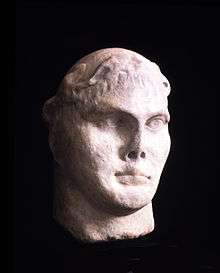 Marble bust of the Roman Emperor Constantine the Great
Marble bust of the Roman Emperor Constantine the Great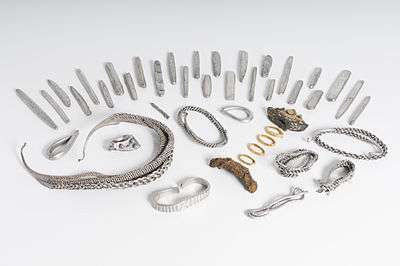 The Bedale Hoard of Viking silver and gold
The Bedale Hoard of Viking silver and gold
Events
The museum has 'Finds Days' in the main Yorkshire Museum building where members of the national British Portable Antiquities Scheme and museum staff will identify objects brought to them by members of the public. The information is also recorded to help build up a more complete archaeological picture of the past.[17]
References
- ↑ Willis, Ronald (1988), The illustrated portrait of York, Robert Hale Limited, 4th Edition, ISBN 0-7090-3468-7, Page 176.
- ↑ Yorkshire Philosophical Society history, Yorkshire Philosophical Society, retrieved on 31 December 2014
- ↑ York Museum Gardens, York Museums Trust, retrieved on 31 December 2014
- ↑ "Exhibitions". Yorkshire Museum website. York Museums Trust. Retrieved 21 January 2016.
- ↑ MLA Programmes designation Archived 22 August 2007 at the Wayback Machine., The Museums, Libraries and Archives Council (2007), retrieved on 4 September 2007
- ↑ Pearce, Susan M. (1996). Exploring science in museums. Continuum International Publishing Group. pp. 35–39. ISBN 978-0-485-90006-4.
- ↑ Biology, Geology and Astronomy, York Museums Trust (2006), retrieved on 8 September 2007.
- ↑ Ashworth, Ian. "Observatory volunteers". Retrieved 3 November 2014.
- ↑ Morrison, Andrew (25 October 2010). "The Yorkshire Museum Refit: Did it "Let the Light In"?". The University of York. Retrieved 2 March 2012.
- 1 2 "Yorkshire Museum marks 'lost' Roman legion". BBC. 29 March 2011. Retrieved 2 March 2012.
- ↑ The Middleham Jewel, The Art Fund, retrieved on 13 October 2007.
- ↑ Archaeology, York Museums Trust (2006), retrieved on 24 June 2007.
- ↑ Cherry, John (1994), The Middleham Jewel and Ring, The Yorkshire Museum, ISBN 0-905807-12-X Pages 4 and 24 to 26.
- ↑ Timpson, Trevor (17 September 2009). "BBC News Channel". Getting the most out of treasure. Retrieved 20 September 2009.
- ↑ "Viking Hoard". Yorkshire Museum. 1 September 2009. Retrieved 20 September 2009.
- ↑ Pantry, Lyndsey (2 July 2015). "'Once in a lifetime' Viking hoard back on display". Yorkshire Post. Leeds. Retrieved 21 January 2016.
- ↑ Object Identification Archived 5 October 2007 at the Wayback Machine., York Museums Trust (2006), retrieved on 14 October 2007.
External links
| Wikimedia Commons has media related to Yorkshire Museum. |
- The Yorkshire Museum and Gardens website
- The Yorkshire Philosophical society
- History of York website
- Historic England. "Museum, Tempest Anderson Hall and abbey remains: Grade I (464225)". Images of England.
- In pictures: Letting in the light BBC